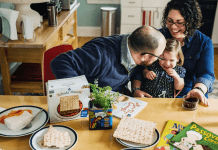My husband and I have walked into my late mother-in-law’s house for the last time.
We are in the process of settling her estate, including the sale of her house and disposition of everything in it.
From a hutch filled with china and crystal goblets to overflowing jewelry boxes and coin collections. And everything in between.
A lot in between.
Her clothes. The Notre Dame sweaters my late father-in-law was so fond of wearing. Her furniture. Furniture inherited from her mother-in-law, still in the same place in the garage where it was originally placed 30 some-odd years ago. My husband’s Cub Scout uniform. Christmas decorations. Lots and lots of Christmas decorations.
Every room, every closet, every shelf, every drawer. Full of stuff. A lifetime of stuff. Two lifetimes, if you count my father-in-law, who passed away 11 years ago.
What to Do With a Lifetime of Stuff
My mother-in-law was a neat and tidy housekeeper. But like many of us (myself included), she lived in a good-sized house with plenty of room to accommodate stuff. Things inherited from her parents and her in-laws. The broken vacuum cleaner waiting for repair in the back of the closet. Hundreds of books read once. You get the picture.
And the cost of disposing of all of that stuff? Having the estate sale company we hired go through every room, every closet, every drawer, separating the trash from the treasures, may cost more than will be generated at the eventual estate sale.
Her house has been transformed into a store, the estate sale company having cleverly arranged and displayed my mother-in-law’s possessions on tables in every room.
All of her possessions with any value, save the very few we kept, each with a tiny white price tag.
Losing your last surviving parent is hard enough. But being the arbiter of which of your parents’ and grandparents’ treasures get saved and which end up sold, donated, or in a landfill? gut-wrenching.
The lesson we have learned from this experience?
Most of the stuff in your house is worthless. And eventually, someone, either you or your kids, will be tasked with the overwhelming job of getting rid of it.
Most of Your Stuff Is Worthless
Most of the stuff in your house is worthless.
Yes, even the stuff you worry the most about, the stuff you think is so good you don’t use it for fear of breaking it, has little to no resale value.
From china, china cabinets, crystal goblets, silver tea sets, pianos, and collectible figurines like Hummels, to grandfather clocks and real pieces of craftsmanship furniture.
Why? Baby boomers have glutted the market with their castoffs, and millennials, the next generation of buyers, don’t want it.
Millennials hate both formal in-home entertaining and use of second-hand goods. With looming student loans, they tend to rent and move often. Who wants to be constantly moving a piano and a grandfather clock from apartment to apartment?
And furniture? There’s no market for so-called “brown furniture,” meaning any furniture (regardless of quality) other than the “mid-century casual” furniture (think clean, lightweight) favored by millennials. Brown furniture is basically firewood.
If it’s not in great condition, it’s also not fit for donation because it can’t be resold.
All of my mother-in-law’s furniture (including the pieces inherited from her mother-in-law and kept for decades)? Straight to the landfill.
Well, Almost Everything…
What do guns, LPs (records), and precious metals/gems have in common?
They are 3 things you might have in your house with a robust resale value.
Silverware also has value, but only if it is real silver and can be melted down.
3 Things You Should Be Doing NOW to Reduce the Amount of Stuff You Have
1. Be viciously thoughtful about holding onto sentimental items.
Here was our goal with sorting through my mother-in-law’s things. Keep just enough to remind us of her, but not so much stuff that our daughters are going to be dealing with it 40 some-odd years from now.
Here’s what we kept:
- A painting to be displayed in our dining room
- My mother-in-law’s treasured Swarovski crystal animal collection (all of which were given to her by her children and grandchildren over the years)
- Jewelry to be divided among the granddaughters
- Each of our daughters got to select 1 item
And that was it.
Well, almost. We did set aside photos to be digitized (with the originals then destroyed).
Was it hard leaving everything else? You bet it was. But we don’t want to be dealing with a lot of stuff years from now (or worse, leaving it to our daughters to deal with).
I try to be viciously thoughtful with my own sentimental items. For example, I don’t save any school papers or art projects from my kids (though I do take photos of my favorites).
2. Buy fewer books.
While used book resellers like Half Price Books do an important service in keeping books in circulation, a surprising number of books end up in landfills because many paper recycling facilities can’t process the the glue that binds book spines.
My resolution last year was to cut down on my book consumption by only reading books that I borrow from the library or purchase on my Kindle e-reader. If you haven’t used a library in years, now is the time to go back. My local library has an app where you can “order” books online, and pick them up the next day on a special “hold” shelf strategically placed next to the check-out kiosk.
How successful was I on my resolution? I read 1 to 2 books a week in 2019, only 1 of which was a hard copy purchased from Amazon.
3. Buy fewer, but better quality, clothes
The world is overflowing with used clothing.
We buy substantially more clothing over our lifetimes than our grandparents did.
Clothing made today is meant to last no more than a few years. In fact, a lot of clothing isn’t even made to withstand more than a few washes.
Think you are “paying it forward” but dropping off a load of unwanted clothes at Goodwill? Think again. Most clothing donations never make it to the racks at Goodwill and only about a third of what does eventually sells.
To really pay it forward, cut down on the amount of clothing you have by buying better quality clothes that last longer.
Keeping What Really Matters
My 5-year-old chose to keep a Christmas music box from her Grandma’s house. It plays “White Christmas” and has tiny ice skaters going around a rink inside. Each Christmas, my mother-in-law would bring out this music box and let each of her granddaughter’s play with it. It’s value in preserving a precious memory of Grandma? Priceless.














I must speak up in Siobhan’s defense. Her use of the word worthless sounds harsh to me, but I know where she is coming from. I spent many painful hours cleaning out my parent’s house and then my mothers one bedroom apt in assisted living. It was emotionally draining and financially fruitless, save for $11,000 in matured savings bonds I found in the bottom of a laundry basket that nearly went to Goodwill, and additional cash squirreled away in the oddest places. Fruitless was a yard sale that took so much work and netted under $250, with the worst part being people grabbing arm loads of stuff priced at a dollar each and offering $3 per lot. And then laughing about reselling it at flea markets.
Like Siobhan, I hired an estate clean out fellow who was kind and honest. He gently explained that things the family assumed were valuable were in fact, not due to the glutted market. We donated what we could; many things were soiled and unsuitable for charity.
Clothes at the thrift shops near me go for $.50 cents on certain days and even so the racks are always full. Expensive jewelry is risky to wear out and about these days, and may not be to one’s taste. Taking pictures of sentimental items and making a collage is a great way to keep memories alive.
As for people needing things, it’s very hard to get stuff into the right hands. Does one fill a truck and drive to an area affected by floods or fire? Baby stuff is unwanted for liability reasons (cribs, playpens, car seats and carriers etc.)
Salvation Army will pick up, but only if the furniture is perfect. Yet they will sell three-legged tables!
Be strong and discerning. Your descendants will thank you!
Having had done this same thing with my mother’s home (she kept everything!) I will say that I completely agree with you. That generation also loved collections. My mom had at least forty “collectors plates” in boxes in the basement. These had never even been displayed. They are a dime a dozen on Ebay, and they didn’t sell at our garage sale. They all went to the thrift store for donation. Even before having to do this- but now I am even more of the mindset of getting down to the basics. I simply don’t understand collecting anything. I guess sometimes it can make people happy- that’s fine. Just remember someone will eventually have to get rid of your snowman/shot-glass/collector plate collection! Thanks for great article.
Actually it’s a very random article, art and quality stuff tend to come back from time to time, only because someone had some random “quality” stuff, it’s not like the real quality stuff is worthless. A signed copper jardiniere … 2000$, same model jardiniere unsigned… 10$. The key is in the details, and humans tend to collect things… rare things.
I always read everything I find from you and I love it all.
It has been helping me a lot in my daily routine .
My house is lighter now that I got rid of so many stuffs no one wanted anymore.
I didnt throw all away though .
I donate to an Ong which works for the poor ppl.
Thanks a lot for the inspiration you spread.
I’m a millenial and I love brown furniture. In fact I prefer it. I can just paint it when I want a slight change in the aesthethic of my home instead of buying something different. I also have a piano.
Estate liquidators sell as much as they can in as little time as they can. They don’t place minimum prices on items or care about the value of the items. In my aunt and uncle’s case, they called in two churches who simply “took” whatever they wanted for free! We had to step in because the income from the sale of some very valuable items was intended to go towards their assisted living care. My six adult children don’t want any of our stuff either. As one estate planner said to my mom, siblings and me, only money talks nowadays for most kids. He urged us to liquidate as much as we can into cash. Offer kids and grandkids a “keepsake” and sell the rest while you have the time, patience and ability to do so and still get a reasonable price for those things that have some value — even if it’s not as much cash value as you might believe. And for those who believe used furniture is valuable, you may be surprised to learn that a lot of secondhand stores no longer accept “soft” furniture (mattresses, couches, easy chairs, etc.) due to liability issues that can arise if the item is found to have things like bedbugs.
My thoughts also.
A few years after my dad died, my mom who was 10 years younger decided it was time to sell the house and downsize. She chose what she would take, let the 8 children take what they wanted, then sold what she could. After that, she invited everyone she knew to just come and help themselves to the rest. For free. Friends, friend’s children, neighbors, colleagues, strangers. It was wonderful. Us kids supervised, it was very friendly and polite, no grabbers or troublemakers, and 95% of the stuff found homes. It was a stroke of genius, sustainability-wise. I highly recommend it.
Not everything is worthless. My husband and I, have sold a lot of coins on eBay and books are a great resell. Artwork, unless by a recognized artist, is worth nothing. Jewelry is another great eBay item. Dishes, vases, etc., are worth almost nothing. We’ve stopped buying clothes and donate to Goodwill or somewhere similar, when we want to get rid of things.
I and my daughters thrift store shop. We have no problem wearing and using barely used things. We see it as saving things from the landfills and reducing the waste when new products are made. We are only 1 family but if many others did it the impact could be huge. Plus we save money on brand names and quality items.